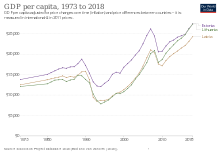Baltic Tigers


Baltic Tiger is a term used to refer to any of the three Baltic states of Estonia, Latvia, and Lithuania during their periods of economic boom, which started after the year 2000 and continued at least until 2007. The term is modeled on Four Asian Tigers, Tatra Tiger, and Celtic Tiger, which were used to describe the economic boom periods in East Asia, Hungary, Serbia, Slovakia, and Ireland, respectively.
Overview


Economically, parallel with the political changes, and the democratic transition, – as a rule of law states – the previous command economies were transformed via the legislation into market economies, and set up or renewed the major macroeconomic factors: budgetary rules, national audit, national currency, central bank. Generally, they shortly encountered the following problems: high inflation, high unemployment, low economic growth and high government debt. The inflation rate, in the examined area, relatively quickly dropped to below 5% by 2000. Meanwhile, these economies were stabilized, and in 2004 all of them joined the European Union. New macroeconomic requirements have arisen for them; the Maastricht criteria became obligatory. Later the Stability and Growth Pact set stricter rules through national legislation by implementing e g the regulations and directives of the Sixpack, because the financial crisis was a shocking milestone.[1]
After 2000, the Baltic Tiger economies implemented important economic reforms and liberalisation, which, coupled with their fairly low-wage and skilled labour force, attracted large amounts of foreign investment and economic growth.[2] Between 2000 and 2007, the Baltic Tiger states had the highest growth rates in Europe. In 2006, for example, Estonia grew by 10.3% in gross domestic product, while Latvia grew by 11.9% and Lithuania by 7.5%. All three countries by February 2006 saw their rates of unemployment falling below average EU values. Additionally, Estonia went from being classified as an upper-middle income economy to a high-income economy by the World Bank in 2006[3] and is now considered among the ten most liberal economies in the world[4] according to the Index of Economic Freedom.
Due to these developments, all the countries had very high capital inflows, that resulted in high current account deficits, circa 10% in 2007.[5] The global financial crisis triggered the collapse of the cross-border capital flows, causing some of the most severe recessions in Europe. A collapse of property markets, real wages decline and rise of unemployment followed. In 2008, Latvia's GDP shrank by −4.6% and Estonia's −3.6% while Lithuania's slowed to 3.0%. As the crisis swept across Eastern and Central Europe the economic reversal intensified: Estonia's GDP dropped by -16.2% year-on-year, Latvia's by −19.6% and Lithuania's by −16.8%.[6] By mid-2009, all three countries experienced one of the deepest recessions in the world.
In 2010 the economic situation in the Baltic states stabilized and in 2011 the Baltic states experienced the fastest recoveries in the European Union, after having lost a substantial part of their populations through emigration, particularly Lithuania. Estonia's GDP grew by 8.3% in 2011, Lithuania's GDP grew by 5.9% and Latvia's GDP by 5.5%.[7] Estonia adopted the Euro in January 2011, Latvia in 2014 and Lithuania entered the Eurozone in 2015.[5]
Statistics
Real GDP growth rate
| 2011 | 2012 | 2013 | 2014 | 2015 | 2016 | 2017 | 2018 | 2019 | 2020 | 2021 | 2022 | |
|---|---|---|---|---|---|---|---|---|---|---|---|---|
| Estonia | ||||||||||||
| Latvia | ||||||||||||
| Lithuania | ||||||||||||
| Data from Eurostat | ||||||||||||
GDP and GDP per capita
| Country | 2013 | 2014 | 2015 | 2016 | 2017 | 2018 | 2019 | 2020 | 2021 | 2022 | 2023 |
|---|---|---|---|---|---|---|---|---|---|---|---|
| 18.911 | 20.048 | 20.631 | 21.748 | 23.834 | 25.932 | 27.765 | 27.465 | 31.445 | 36.181 | 37.682 | |
| 22.791 | 23.626 | 24.572 | 25.371 | 26.984 | 29.154 | 30.679 | 30.265 | 33.617 | 39.063 | 40.310 | |
| 35.040 | 36.581 | 37.346 | 38.890 | 42.276 | 45.515 | 48.916 | 49.829 | 56.154 | 66.791 | 72.048 |
| Country | 2013 | 2014 | 2015 | 2016 | 2017 | 2018 | 2019 | 2020 | 2021 | 2022 | 2023 |
|---|---|---|---|---|---|---|---|---|---|---|---|
| 14,320 | 15,240 | 15,710 | 16,530 | 18,120 | 19,660 | 20,960 | 20,670 | 23,640 | 27,170 | 27,590 | |
| 11,320 | 11,850 | 12,430 | 12,950 | 13,900 | 15,130 | 16,040 | 15,920 | 17,850 | 20,710 | 21,440 | |
| 11,850 | 12,480 | 12,860 | 13,560 | 14,950 | 16,250 | 17,510 | 17,830 | 19,990 | 23,580 | 25,070 |
See also
Economies of the Baltic Tigers:
Other 'Tigers'
References
- ^ Vértesy, László (2018). "Macroeconomic Legal Trends in the EU11 Countries" (PDF). Public Governance, Administration and Finances Law Review. 3. No. 1. 2018. Archived from the original (PDF) on 12 August 2019. Retrieved 12 August 2019.
- ^ "WORLD ECONOMIC OUTLOOK DATABASES". www.imf.org.
- ^ "World Bank Country and Lending Groups – World Bank Data Help Desk". datahelpdesk.worldbank.org. Retrieved 11 January 2024.
- ^ "Country Rankings: World & Global Economy Rankings on Economic Freedom". www.heritage.org. Retrieved 11 January 2024.
- ^ a b "Convergence and adjustment in the Baltic States" (PDF). ECB Economic Bulletin. 2017 (5). European Central Bank: 21. 2017. doi:10.2866/010349. Retrieved 12 December 2024.
- ^ "Latvia's rating cut as GDP falls 19.6%". Financial Times. Retrieved 29 January 2021.
- ^ "GDP of Latvia increased by 5.5% in 2011". The Baltic Course. 9 March 2012. Retrieved 24 March 2012.
- ^ a b "Gross domestic product at market prices (Current prices and per capita)". Eurostat.
